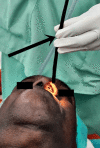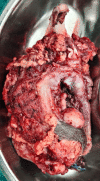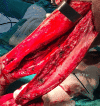Anaesthetic Challenges in a Case of Oral Carcinoma With Anticipated Difficult Airway Posted for Tumour Excision and Reconstruction Surgery
- PMID: 36883095
- PMCID: PMC9985923
- DOI: 10.7759/cureus.34599
Anaesthetic Challenges in a Case of Oral Carcinoma With Anticipated Difficult Airway Posted for Tumour Excision and Reconstruction Surgery
Abstract
Mandibular surgery, edentulous jaw, denture wear, and ageing are all risk factors for persistent mandibular ridge resorption and weakening. The tongue occludes the upper airway due to the mandible's edentulous condition. All of these factors contribute to the difficulties in regulating the airway. An adequate preoperative review assisted in classifying this index patient as having a high risk of difficult airway management, and appropriate actions were made to facilitate effective airway care. A 60-year-old male presented to casualty with a complaint of squamous cell carcinoma of the right buccal mucosa and was posted for wide local excision of the tumour, segmental mandibulectomy, bilateral modified radical neck dissection, and reconstruction with a fibular free flap. He had a restricted mouth opening and a heavy jaw, with Mallampati grade 4 and had an anticipated difficult airway. Hence, awake endotracheal intubation was done by flexible fibreoptic bronchoscope following airway blocks and an 8.0 mm cuffed flexometallic armoured tube was secured at 28 cm at the angle of the nose. Bilateral modified radical neck dissection and wide local excision of the tumour were done followed by mandibulectomy and its reconstruction by fibular free flap and anastomosis was performed. Tracheostomy was performed and the patient was shifted to the intensive care unit and kept knocked out with injection vecuronium and injection midazolam infusion. The patient was gradually weaned off the ventilator the following day and discharged on postoperative day 12 with minimal postoperative complications. A thorough pre-anaesthetic plan, simple and skilled anaesthetic management strategy, and well-organized teamwork aided in the effective anaesthetic care of this challenging airway patient.
Keywords: anaesthesia; awake intubation; fibreoptic bronchoscope; predicted difficult airway; reconstruction surgery.
Copyright © 2023, Dash et al.
Conflict of interest statement
The authors have declared that no competing interests exist.
Figures










References
-
- Current concepts in management of oral cancer - surgery. Shah JP, Gil Z. https://pubmed.ncbi.nlm.nih.gov/18674952/ Oral Oncol. 2009;45:394–401. - PMC - PubMed
-
- Oral cancer in India: an epidemiologic and clinical review. Sankaranarayanan R. https://pubmed.ncbi.nlm.nih.gov/2179801/ Oral Surg Oral Med Oral Pathol. 1990;69:325–330. - PubMed
-
- The pectoralis major myocutaneous flap. A versatile flap for reconstruction in the head and neck. Ariyan S. Plast Reconstr Surg. 1979;63:73–81. - PubMed
-
- Involvement of viral factors with head and neck cancers. Gondivkar SM, Parikh RV, Gadbail AR, Solanke V, Chole R, Mankar M, Balsaraf S. https://pubmed.ncbi.nlm.nih.gov/22078009/ Oral Oncol. 2012;48:195–199. - PubMed
-
- A data review of airway management in patients with oral cavity or oropharyngeal cancer: a single-institution experience. Zheng G, Feng L, Lewis CM. https://bmcanesthesiol.biomedcentral.com/articles/10.1186/s12871-019-0770-2. BMC Anesthesiol. 2019;19:92. - PMC - PubMed
Publication types
LinkOut - more resources
Full Text Sources
